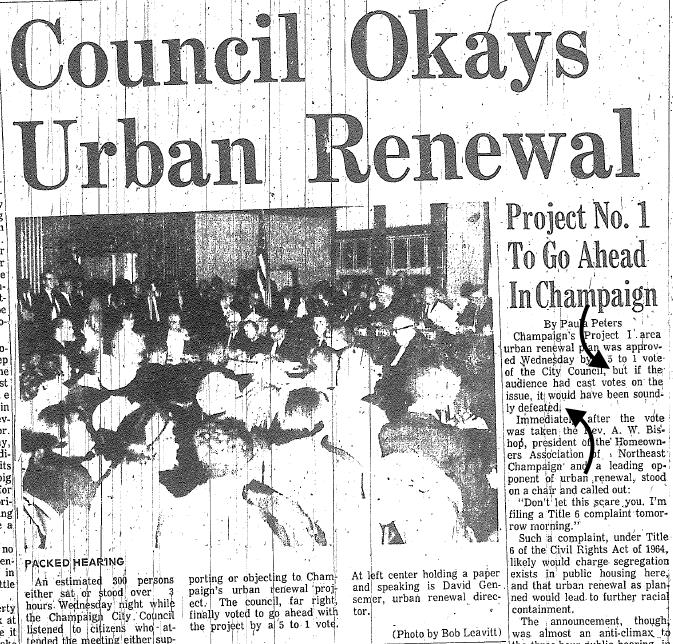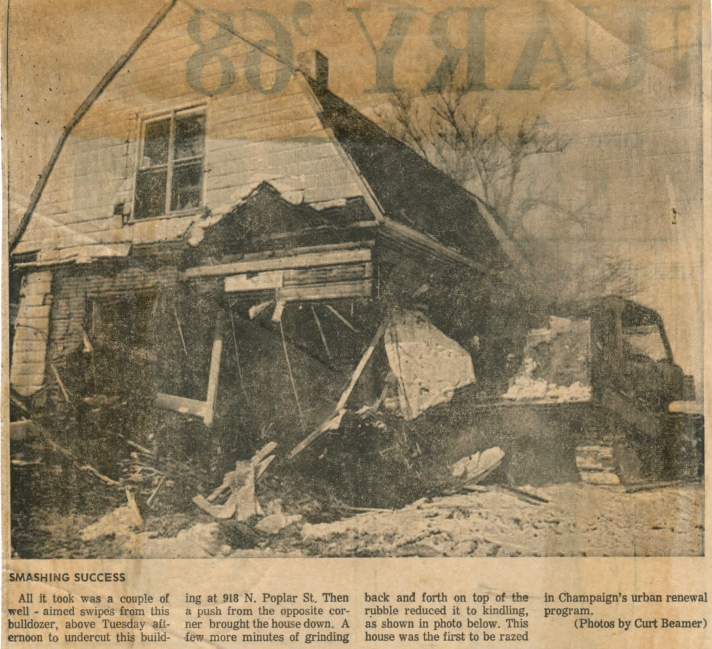
“Smashing Success”: 918 N. Poplar St.: first to be razed in Champaign’s urban renewal program in 1968.
Forcing people to move from their homes is one of the most intrusive exercises of state power. It is difficult to overstate the combined financial and psychological impacts that the loss of a home has on an individual. It is even more difficult to accurately measure the long-term effects of losing a home in terms of other life opportunities. Forced residential displacement disrupts the social support networks and survival strategies used by people in their everyday lives.
What “home” means to most Americans is often very different from political discussions of “housing.” The actions of local contractors, home builders, lenders, insurers, appraisers, real estate agents, and others all make up a unique local network that determines the availability and cost of housing in any given community.
National urban renewal, 1954-1974
“Old urban renewal” officially began in 1949, when Congress stated that new houses should be built across America in order to realize “the goal of a decent home and a suitable living environment for every American family.” Congress provided billions of dollars in federal resources to local authorities to redevelop “blighted” areas over this twenty-year period. Urban renewal’s original goals were clearing industrial slums and rehousing the poor in public housing.
Legal historian Wendell Pritchett’s “discourse of blight” became central to justifying urban renewal policy. “Blight” was posed as a disease that threatened to turn healthy areas into slums. By declaring specific real estate property dangerous to the future of the city, renewal advocates were able to change the law to expand the state’s ability to use eminent domain against its residents. During this time, “scientific” approaches to cutting out “blight” and other inefficient land uses combined with the judiciary’s re-definition of “public benefit” to create the destructive racial legacies that urban renewal carries with it today.
“Old” urban renewal officially ended in 1974. Between 1954 and 1974, urban renewal was associated with bulldozing an estimated 2,500 neighborhoods in 993 cities. Most of these residential units were older tenements and single-family homes that typically housed African-Americans. Urban renewal “slum clearance” did not clear slums at all – it merely relocated them within the city. It is estimated that around 1.6 million people were forced out of their homes from urban renewal redevelopment projects. Nationally, “old” urban renewal displaced poor city residents, did not adequately provide for their relocation, and seemed dedicated to increasing downtown urban wealth by getting rid of the less affluent through forced residential displacement.
Urban renewal-based residential displacement broke many existing social networks, causing widespread emotions of sadness, grief, and depression at the individual level that were widely documented by sociologists, psychologists, and housing experts. These negative emotional impacts were the strongest and the longest lasting for those who had strong ties to family, friends, and neighbors who were also from the neighborhood that was redeveloped.
“Old” urban renewal in Champaign
“Old” urban renewal came to Champaign in 1960, when a Citizens Advisory Committee on Urban Renewal (CAC) was formed from an initial community meeting with Mayor Emmerson Dexter and 30 local residents. The primary issues debated in our community over the next nine years were:
(1) Desegregation of housing in the C/U community
(2) Champaign’s poor city code enforcement
(3) Concentration of public housing in the North End
(4) No equal opportunity for local minority contracting.
(1) Desegregating housing
The first public opposition to the idea of C/U doing an urban renewal project occurred in early 1962. Despite the planning director and City Council’s attempts between 1960-1964 to avoid committing to desegregation simultaneously while implementing urban renewal, the C/U community insisted in public sessions and neighborhood meetings that we could not do one (urban renewal) without the other (desegregation).
On March 31, 1963, after nine months of preparation, traffic engineers and urban planning consultants Harland Bartholomew and Associates presented its plan to the city. The General Neighborhood Renewal Plan contained six projects covering 227 acres, requiring 800 families to be relocated, with 200 not to be disturbed. Of the existing 941 structures, 52.5% were planned for complete demolition. The first public hearing on the 1963 draft urban renewal plan was held on December 20, 1965. Two spectators spoke in favor of the plan, and 30 voiced opposition. One of the public comments made was: “One thing that is confusing me is that we’ve all had men come out and tell us one thing but when they get back to the west side they talk differently. I’ve heard some people say that if this project goes through I’ll make a killing off these Negroes in the North End.”
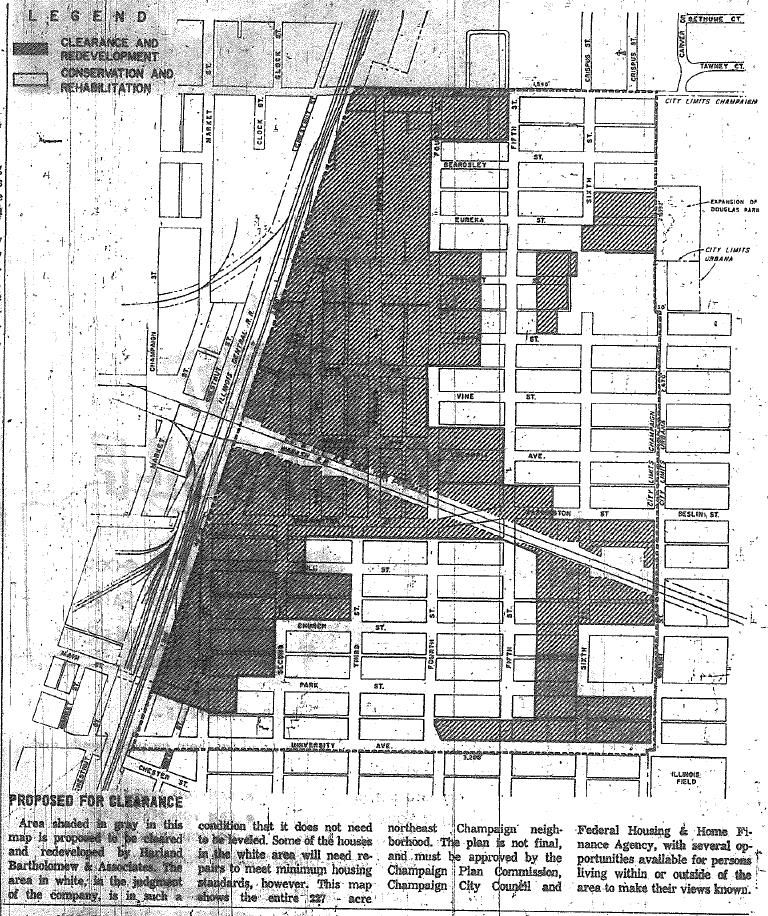
Shaded areas slated for total demolition in Champaign’s “old” urban renewal. Source: “First Area Chosen for Urban Renewal,” Courier, March 31, 1963
Concern for the “human side” of urban renewal was voiced by several community groups at this time. Their primary fear was that the city was only concerned with improving the structural condition of the neighborhood, and not the situations of its residents. From early 1964 through mid-1965, those who lived in the proposed renewal area began to get more actively involved in CU’s “old” urban renewal controversy.
The main opposition neighborhood group was the Northeast Neighborhood Homeowners Association, led by Reverend A. W. Bishop. This North End neighborhood had about 70% owner-occupied homes, and its residents were a median age of 50 years old. Their primary concern was losing their homes, their single largest asset. The minutes from a community meeting on January 25, 1966 stated:
“…they were too old to leave their homes which they owned and purchase news ones. They felt they would be forced into renting, and said, ‘I worked hard for my shack, and I intend to keep my shack till I die,’ and ‘All my earnings, all my savings are in that home. My husband is sick and not able to work, and I’ve already got enough problems without losing my home.’”
These residents tried to save their homes in order to avoid being placed into public housing, because urban renewal and public housing seemed two sides of the same coin.
The Champaign-Urbana Improvement Association, one of the groups that had previously opposed the project, reversed its stance in mid-1964 with the following “reservations”:
“We don’t unanimously agree that urban renewal is the best thing for Champaign’s North End…our experience in the past is all we can go by, and we have seen it fail in other cities, at least what most of them have is not what we want…but we must do something to help stop a problem that could get out of hand given 10 years or more…so we support this with the following reservations:
1. The cost of new homes must not be beyond the ability of the average wage-earner now living in the area to purchase and maintain.
2. Profiteering on the part of private developers should be discouraged.
3. Reasonable assurance should be given and a climate established whereby displaced persons may be allowed to buy homes outside the renewal area.
4. A fair price should be paid for homes taken, and after the sale, if the occupants did not have sufficient funds to purchase their property, they would he subsidized by the government with low-interest loans to assure adequate housing.
5. Homeowners located in the renewal area whose homes are classified as substandard will be allowed to bring their homes up to the present code requirements.
6. Public housing should be minimal and be designed as not to take on the appearance of ghetto housing.
7. Developers in the renewal area must hire Negroes in all job categories.”
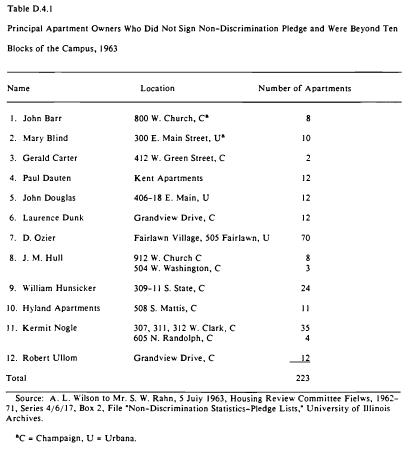
Investment property owner John Barr failed to sign UIUC housing’s non-discrimination pledge, yet was still appointed new CAC chair by Mayor Emmerson Dexter in 1965. Source: Carrie Frank (1990) “Injustice Sheltered: Race Relations at the University of Illinois and Champaign-Urbana, 1945-1962” (1990)
By the June 2, 1965 meeting of the Neighborhood Committee of the CAC, the mayor had appointed John Barr, a local realtor, as chairman of the Committee. Mr. Barr stated that he thought there could be an urban renewal plan that truly benefited the North End if the people in the area participated in creating the plan: “Urban renewal could help the community of Champaign-Urbana, but … it was a grave error to have a plan without much participation from the people affected.” Mr. Barr further said that although urban renewal could possibly create more problems than it solved, it was foolish to try to separate urban renewal and integration. Soon after, the CAC issued a statement supporting a program that fostered integration.
(2) Lax City Code Enforcement
After two local children were killed in a 1953 fire from a structure burning so rapidly they could not escape, public opinion demanded that the city do something about housing conditions in the North End. As a response, the first minimal housing code in Champaign was created, which prohibited dirt floors and designated space requirements per person. However, enforcement remained the primary problem. City code enforcement relied on complaints, not routine inspections. The League of Women Voters reported that not only were “the offices of the building inspectors understaffed and neighbors unwilling to make complaints, [but] in the absence of routine inspection or complaints from others, many violations, particularly in the poorer neighborhoods, [go] undetected.” Even more, “public opinion, unfortunately, does not support enforcement.”
The community continued to debate the merits and potential pitfalls of implementing a local urban renewal program as a solution to local conditions of “blight.” Planning Director David Gay explained the City’s perspective on renewal at the time:
“…one alternative is simply to practice rigid enforcement of the city building codes…but then the city would have no legal obligation to relocate occupants of substandard housing: it would not be liable for damages to property owners and it would not be required to purchase the condemned property at fair value. The trouble is that slums are profitable to some property owners. Properties there are cheap and can be paid for in a short time. There is no upkeep required and they provide income for the life of the property.”
This perspective on upkeep of residential property in the North End (“none required”) is representative of attitudes held by both individual property owners and early city code inspectors at the time. Not enforcing city codes is one of the ways Champaign’s local government contributed to creating the “blighted” conditions urban renewal was supposed to solve.
(3) Housing Authority of Champaign County (HACC) promotes segregation
Housing in C/U before “old” urban renewal began was too expensive for the majority of its residents. In 1951, Champaign built 70 public housing units for whites and 70 units for blacks; Urbana built 99 for whites and 26 for blacks. African-Americans and whites were segregated, but “equal facilities were provided for each group” according to the League of Women Voters. The African-American project in Champaign was called Birch Court (locally known as Burch Village, new mixed income development re-named Douglass Square in 2005). The cost of Champaign’s two projects was $1,470,000, but only 21% went towards constructing Birch Court.
The HACC restricted residential eligibility by income and race at the time, as well as previous housing circumstances. In Champaign, a six-person non-political committee gave consideration to the length of residence in the community and to the “character” of the applicant. The tenants were expected to be “good risks for the prompt payment of rent and to be cooperative citizens, not trouble-makers.” The task of selecting tenants along these lines was clearly highly subjective, and mistakes were probably made. The very poorest families were ineligible because their incomes were not steady or large enough to pay the minimum rent necessary by federal financing rules. Many African-Americans’ incomes were declared too high for public housing, but they could not find better privately-owned housing because of color restrictions outside the North End. As a result, there were four eligible applicants for every vacancy.
Many residents opposed the segregationist practices of the housing authority. Two lists were kept: one white and one black. Housing was thus not provided on a first-come, first-served basis. This created intense distrust and suspicion in the run-up to Champaign’s first “old” renewal project, because the inclusion of public housing as part of the renewal plan was vigorously debated.
In 1965 to push Champaign’s urban renewal plan forward, the mayor drew a line in the sand: “I can tell you right now that if the units are not to be placed – in the urban renewal area, all meetings on the subject might as well ‘go out the window.’ There will be no urban renewal unless these units are built inside Project I.” Despite a three-hour public hearing during which “councilmen listened to 13 talks favoring the urban renewal plan and 26 opposing it,” on November 17, 1966 Champaign’s Urban Renewal Project I was approved by a 5-1 City Council vote.
The tensions around urban renewal and race relations came up early and often in the beginning stages of CU’s Old Urban Renewal project planning. As Mr. Barr explained to HUD:
“Early in the planning period we were advised that urban renewal and race relations were two separate problems and we should not try to mix the two. We have learned, however, that at least here in Champaign the two problems cannot be separated…despite this awareness by the City, some of the conflicts have not proved fully reconcilable. The most intense and concerted ‘segregation’ charge has involved the proposal to locate sixty units of public housing within Project I. This problem has been consistently opposed by civil rights groups and others concerned over the possible perpetuation of the ghetto pattern.”
By 1969, 106 out of 135 total families targeted for “old” urban renewal in Champaign had been relocated. Resident relocation problems were complicated by the existing practices in the segregated housing unit assignments of the HACC. Because applicants had been assigned to the housing units on a racially segregated basis, at this time the CAC issued a formal request that the HACC assign public housing on a first-come, first-served basis. Even though City Manager Browning said that City Council did not want to put pressure on another public body, City staff at this time recommended that the HACC fill all vacancies in public housing units on a first-come, first-served basis without regard to race. But debate in Champaign continued over the placement of public housing relative to urban renewal areas in the North End.
Public pressure against concentrated public housing was incredibly intense. In September 1971, over 200 citizens from Champaign’s North End attended a Champaign City Council meeting in a protest against a proposed public housing project in the urban renewal area. “The north side of Champaign,” declared a spokesman, “is already over saturated with public housing. As a result of increased density, crime rates will increase, traffic will become unmanageable, sanitation problems will become worse and property value will decline greatly.” Jim Williams, director of the Champaign Department of Environmental Development, in 1973 described these protests as basically racist: “the residents were concerned about black minority people in the area.” Two of the most vocal leaders of that protest were Jim Cross, a Champaign fireman, and his wife Linda, who lived a block away from the proposed North Harris Street site. The Crosses raised a zoning petition later passed by the Champaign City Council to prohibit additional public housing projects north of University Avenue. They argued that the city dumped the public housing projects north of University Avenue “because other areas of Champaign have the prestige or influence to stop such projects.”
(4) Unequal opportunity for local minority contracting
Urban Renewal Project I moved forward in Champaign regardless of community debates, and 1969 brought additional race-based community challenges in the process of selecting a developer. Creative Buildings, a local Urbana firm, already had a contract to build a 72-unit apartment project in the renewal area for Mt. Olive Baptist Church. Creative Buildings had promised to help organize a black construction firm to help handle the on-site assembly of pre-constructed housing modules for the new planned urban renewal development, but CAC members expressed doubt about hiring Creative Buildings.
CAC Vice Chairman Henry Spies said he “was not sure banks would finance such a firm, even with backing from Creative Buildings.” Chairman John Barr said that since the housing modules would be pre-built, “I can’t see what work besides a little painting and site preparation remains to be contracted.” Mt. Olive Baptist Church Reverend James Offutt argued that the proposal would both create jobs for blacks in the Creative Buildings factory where the modules are built, as well as on the assembly site in the renewal area. The relocation officer for the urban renewal department told the CAC that a number of black skilled craftsmen in C/U had been unable to find work because of trade union discrimination. Another committee member said he doubted the unions would accept constructing the housing project with non-union labor. However, some unions had apparently indicated a willingness to allow black craftsmen to work on projects in the urban renewal area, and to admit them to the unions afterwards if they were able to “prove themselves.” Reverend Offutt scoffed at this, saying: “That’s ironic, I have to ask the person with his foot on my neck for permission to work in my own area.”
The Champaign City Council had the final choice in selecting a developer, but the CAC eventually recommended who it considered had the best design – Lippman Associates out of St. Louis. This recommendation was made despite not knowing whether Lippman would be willing to make an extra effort to employ local craftsmen.
President of Creative Buildings Roy Murphy appeared before City Council during budget hearings later that year to protest his company’s treatment in the bidding process. He argued “there had not been a fair opportunity to bid openly and competitively on the housing projects.” CAC member Harry Spedes responded by saying the project specifications were provided by the Federal Housing Authority, and the CAC’s recommendations for a developer were based on “what they believed would be the best plan for the area.” Robert Pope, a conservative Council member on record as opposing Champaign’s urban renewal project, argued that Mr. Murphy’s critiques of City contracting were unfounded. Mr. Pope argued that local construction companies would naturally benefit from urban renewal, “even those which will not receive any of the contracts, such as those owned by several of the city councilmen,” because “if certain companies are engaged in federal projects, fewer companies would be left to handle the normal business.” But when African-American skilled craftsmen were not allowed into local unions, their real opportunities for receiving local contracts remained incredibly slim. There might have been positive market effects for the local white construction companies using unionized labor, but not for local skilled black craftsmen.
Pope’s reasoning does not engage with the real issue here – that local prejudice against African-Americans went so deep that it affected trade union membership, which directly affected skilled black laborers’ local job opportunities and therefore earning capacity. The result in our community was a network of contracting and hiring preferences that benefited white laborers and businesses directly at the expense of blacks.
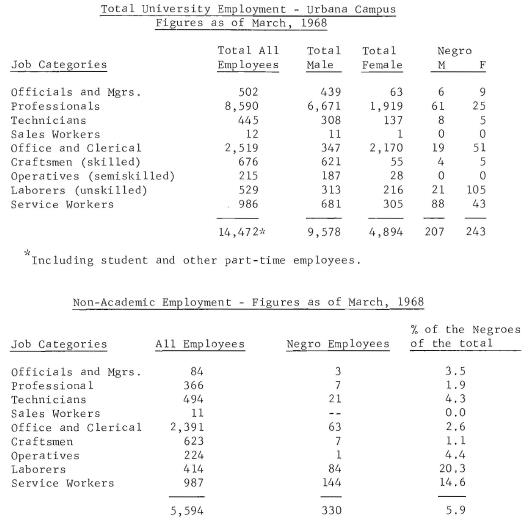
Source: “A Community Report – Twenty Years Later: The Status of the Negro in Champaign County,” League of Women Voters (1968)
Housing desegregation, poor code enforcement, local public housing policy, and unequal opportunity for minority contracting were the major issues in “old” urban renewal debates in Champaign. It is very clear that despite widespread and vocal protest by African-American residents concerned about unequal outcomes, the City staff and elected officials responsible for Champaign’s “old” urban renewal project had their own opinions and agendas. These agendas disregarded the repeated voiced preferences of an entire group of citizens. The events discussed here also indicate a changing racial climate leaning towards desegregation. However, discrimination and community resistance to real racial integration continued.
Second in a series.
Natalie Prochaska is an urban planning consultant who specializes in diversity and inclusion issues related to housing provision and community development and a CU native. She currently divides her time between Illinois and Europe and enjoys being a volunteer with grassroots anti-incarceration efforts in Champaign.


